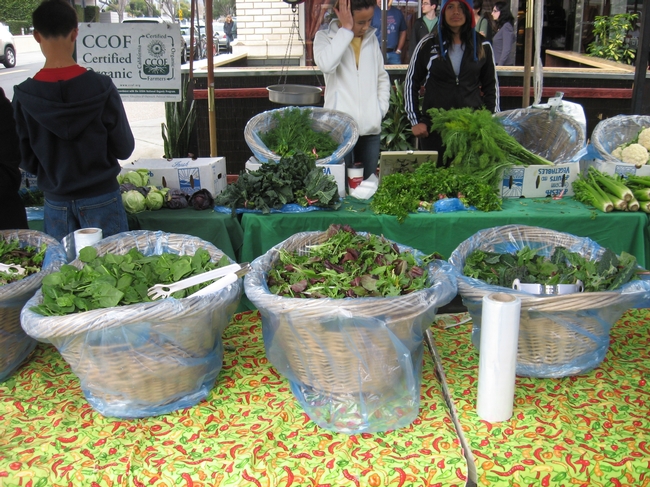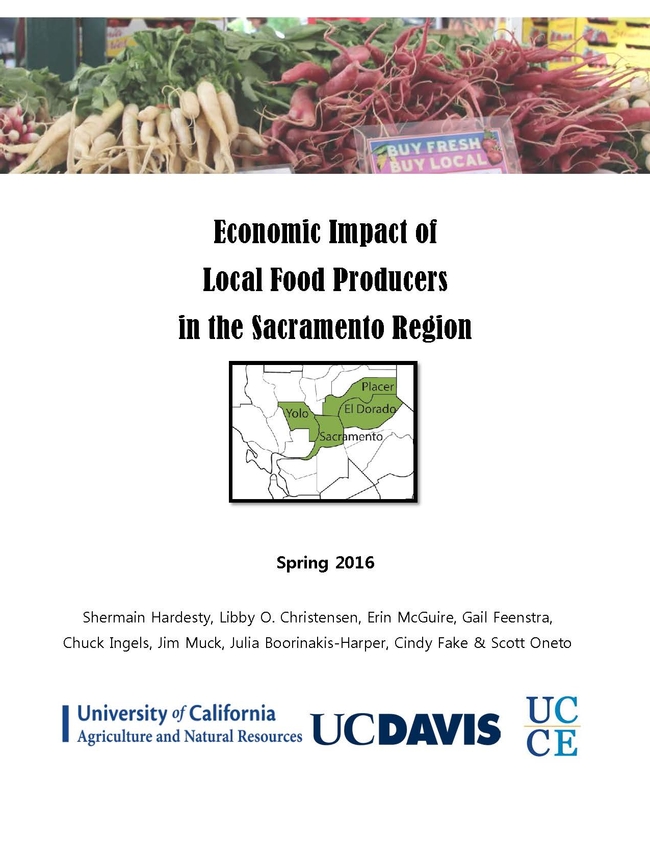
Our University of California Cooperative Extension team measured the economic impact of local food marketing in the Sacramento Region (El Dorado, Placer, Sacramento and Yolo counties). Our key finding was that, for every dollar of sales, Sacramento Region producers engaged in direct marketing (direct marketers) are generating twice as much economic activity within the region as producers who are not involved in direct marketing (non-direct marketers). This strong economic development impact is due primarily to the fact that direct marketers source a much larger percentage of their inputs within the region (89 percent) than do non-direct marketers (45 percent).
We used an input-output modeling program, IMPLAN, to measure the direct marketers' economic impacts. Our project team interviewed over 100 direct marketers in the Sacramento Region to develop a customized IMPLAN database. We asked producers what, where, and how much they spent for inputs in various categories, as well as what, where and how much product they sold. The direct marketers were much more labor intensive; hired labor comprised 45 percent of their total expenses, compared to 25 percent of total expenses for the non-direct marketers. Additionally, most direct marketers also sold through other channels; on average, 44 percent of their revenues were generated through direct marketing, 55 percent through wholesale channels, and one percent in commodity markets.
Three levels of economic impact related to local food marketing can be measured: direct, indirect and induced. Imagine a customer goes to a farmers market in the Sacramento region and buys $10 of vegetables from Farmer Brown. There is a direct effect of 1, which generates $10 in revenue for Farmer Brown. There are also ripple effects 
The second ripple effect is called the induced effect. In this example, Farmer Brown spent money to hire labor and purchase inputs. Her spending generates income for her farm, her employees, her suppliers, and the employees of her suppliers—including the sales person at the hardware store. The induced effect occurs when these households spend some of their income on products and services within the region, such as food, clothing, health care, eating out, and recreational activities. The induced effect was .45 for the direct marketers and .33 for the indirect marketers. The induced effect from Farmer Brown's production of $10 of vegetables generated $4.50 of household spending in the Sacramento Region. The direct, indirect and induced effects are added together to calculate the total output multiplier—measuring the total economic impact of one dollar of output. The total output multiplier is 1.86 for the direct marketers, and 1.42 for the non-direct marketers.
There are also large differences in the job effect of the two producer groups. The direct marketers generate 31.8 jobs in the Sacramento Region for every $1 million of output they produce. These jobs include on-farm labor, as well as jobs related to the farms' indirect effects, which involve the farms' suppliers, and jobs created by the direct marketers' induced effects involving household spending. In comparison, the Sacramento Region non-direct marketers generate 10.5 jobs for every $1 million of output. The difference is attributable mainly to two factors: (1) the direct marketers' high rate of local input sourcing; and (2) the direct marketers' labor intensiveness--hired labor expenses comprised 45 percent of their operating expenses, compared to only 25 percent for the other producers.

Readers need to be aware that these results apply only to the Sacramento Region. Gathering the data to develop a custom IMPLAN database for direct marketers is very time-consuming.
Report authors are the following current (and former) UC Cooperative Extension academics and staff: Shermain Hardesty, Libby O. Christensen, Erin McGuire, Gail Feenstra, Chuck Ingels, Jim Muck, Julia Boorinakis-Harper, Cindy Fake and Scott Oneto. The full regional report, as well as similar reports for El Dorado, Placer and Yolo counties, may be downloaded at: http://ucanr.edu/econ_impact. Inquiries may be sent to the project leader, Shermain Hardesty, shermain@primal.ucdavis.edu.